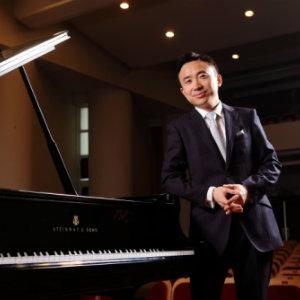This concert was also the vehicle for a piano performance with the orchestra by William Chen, whose success as a developing soloist began when he came to live for a time in Australia. Chen’s return for this concert was to premiere the Piano Concerto by Australian composer George Palmer. This work was inspired by an eighth century Chinese poem, The Withered Tree by Han Yu. This programmatic suggestion and its metaphor for the hope of the Chinese society further extended the Chinese-Australian links for this event. This work was also exciting simply due to the nature of it being a world premiere and bringing together the SYO with a Chinese virtuoso as well as a prolific Australian composer.
The dramatic blend of emotions and pianistic styles in Palmer’s Piano Concerto made this work a tremendous vehicle for William Chen’s virtuosity. Bravura aside, his cantabile moments penetrated the fine acoustic at the Concourse concert hall and many an audience member’s heart for a considerable time afterwards.
In addition to George Palmer’s entertaining and finely written work, we heard Paul Stanhope’s interesting Fantasia on a Theme by Vaughan Williams (2003). The architecture of this clever work, which varies a chorale tune, was well presented by the SYO. All the challenges of Stanhope’s writing, especially for the wind and percussion instruments, were well answered by this prodigiously talented and fresh orchestra.
This concert’s cultural exchange began with the orchestral piece Evening Party (1934). This was an important beginning to the evening, as it featured the work of He Luting. Luting was trained in the Western tonal tradition and was targeted because of his brave defence of the same during the Cultural Revolution. The piece, filmic in style, was a great start to the display of the SYO’s technical and interpretative skill.
A variety of instrumentation also came in the form of a popular Chinese piece, Hua Yuanjun’s The Moon Reflected on Erquan. A string quartet comprised of SYO principals rendered the popular piece discovered post-Cultural Revolution in a sensitive performance.
With commentaries and introductions from the Australian and Chinese FM radio representatives, these four works made a sizeable musical and cultural event on their own. However, following interval, Max McBride led the SYO in the sprawling Symphony No 5 in E minor Op 64 by Tchaikovsky.
The stamina displayed to perform this work at the end of a concert featuring the works already heard was enough to cement the standing of the SYO as a musical team to be reckoned with. It also dispelled some thoughts in my mind that the programme and commentary threatened to offer a concert a little on the lengthy side. However, this final work did not suffer.
The clarity of both ensemble climaxes and solo work was augmented by a mature reproduction of the grand design of Tchaikovsky’s work. The requisite pathos and determination was not missing from the well-balanced texture. The successful solo and sectional work once again featured the winds to fine effect.
This symphony’s conclusion of the special concert programme ensured audience members left this event proud of this young Australian orchestra and touched by its delivery of both national compositions and musical highlights of another culture.
Rating: 4 ½ stars out of 5
Sydney Youth Orchestra presents William Chen
Conductor: Max Mc Bride
With William Chen, piano
Concert Hall, The Concourse, Chatswood
July 29





